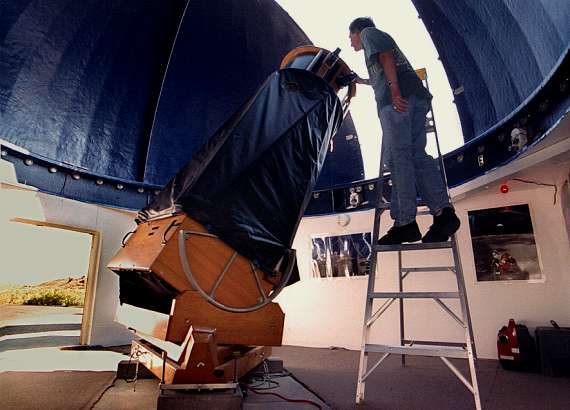A few individuals stand apart within the amateur astronomy world for driving forward the hobby we find so enjoyable. Tom Johnson of Celestron, who found a commercially viable method of producing the Schmitt corrector plate used in Catadioptric telescopes in the 1970’s including the ubiquitous Celestron 8 SCT would be one. Another would be Al Nagler of Televue who revolutionised eyepiece designs with the launch of his wide-field 82o Nagler range in the early 1980’s. With this unique group stands another, John Dobson, who revolutionised amateur astronomy in the 1960’s with the Altitude-Azimuth mount which bears his name, the Dobsonian. It was reported yesterday by the San Francisco Sidewalk Astronomers on their website that sadly John Dobson passed away peacefully on the morning of 15 January 2014, aged 98.
Dobson was born on 14 September, 1915, in Beijing, China, where his maternal grandfather had founded Peking University in 1898. The family moved to San Francisco in 1927 due to political and social unrest in China. He graduated from the University of California, Berkeley with a master’s degree in chemistry in 1943, before spending just one year working in the corporate world before joining the Vedanta Society monastery where he remained for 23 years as a monk of the Ramakrishna Order. During his time with the monastery, one of his tasks was to reconcile astronomy with the society’s teachings.
Dobson’s first experience of telescope making came in 1956 when he built a 2” refractor using a lens purchased from a junk shop and an eyepiece from an old pair of Zeiss binoculars through which he was able to see the rings of Saturn. One of his fellow monks mentioned to him that it was possible to grind a telescope mirror and using a marine-salvaged 12” porthole glass, he made his first telescope mirror. When he looked through the scope at a last-quarter Moon he was surprised and deeply moved by what he saw. His first thought was “Everybody’s got to see this.” In 1958 he transferred to the monastery in Sacramento and started to get seriously involved in telescope building. His lack of money and possessions while a monk, forced him to use scrap materials to build his scopes and were made from discarded hose reels, lumber core cut-outs from school house doors, and scrap wood. These scrap materials formed the humble origin of the mount design that would bear his name. It was suggested by many that he should patent his design but he never thought of it. His mission was to get as many telescopes out into the world as possible.
He left the monastery in 1967 and decided to dedicate his life public service astronomy and hitchhiked to San Francisco and co-founded the San Francisco Sidewalk Astronomers the following year with two of his students, Jeff Roloff and Bruce Sams where the club members would set up their scopes on city streets for passersby to view the wonders of the night sky and learn more about astronomy. By 1970 the group had a 24” telescope. Over the following decades Dobson became a titan for the popularisation of stargazing.

A 25″ Obsession Dobsonian, a scope that would not be possible without the work of John Dobson. Credit: Obsession Telescopes (http://www.obsessiontelescopes.com/index.php)
He will be remembered most for his unique approaches to making low-cost, large-aperture Newtonian reflectors. Today millions of amateur astronomers around the world use Dobsonian scopes of all shapes and sizes, both home and commercially made, thanks to the pioneering work he did.
On the 8th of March 2014, the Sidewalk Astronomers will dedicate this year’s International Sidewalk Astronomy Night to his memory.






